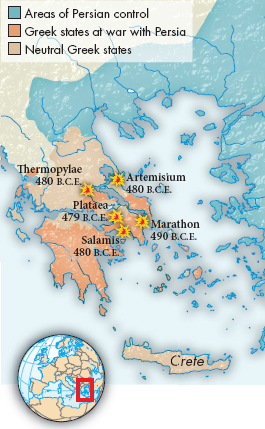The Persian Wars

The Persian Wars, 499–479 B.C.E.
In 499 B.C.E., the Greeks who lived in Ionia rebelled unsuccessfully against the Persian Empire, which had ruled the area for fifty years (see Chapter 2). The Athenians had provided halfhearted help to the Ionians in this failed rebellion, and in 490 B.C.E., the Persians retaliated against Athens, only to be defeated by the Athenian hoplites at the Battle of Marathon.
In 480 B.C.E., the Persian king Xerxes I (r. 485–465 B.C.E.) personally led a massive invasion of Greece. Under the leadership of Sparta, many, though not all, Greek poleis joined together to fight the Persians. The first confrontations between the Persians and the Greeks occurred at the pass of Thermopylae (thuhr-MAWP-uh-lee), where an outnumbered Greek army, including three hundred top Spartan warriors, held off a much larger Persian force for several days. The Greeks at Thermopylae fought heroically, but the Persians won the battle and subsequently occupied and sacked Athens.
At the same time as the land battle of Thermopylae, Greeks and Persians fought one another in a naval battle at Artemisium off Boetia. The Athenians, led by the general Themistocles, provided the heart of the naval forces with their fleet of triremes, or oar-propelled warships. Storms had wrecked many Persian ships, and neither side won a decisive victory. Only a month or so later, the Greek fleet met the Persian armada at Salamis, an island across from Athens. Though outnumbered, the Greek navy won an overwhelming victory by outmaneuvering the Persians. The remnants of the Persian fleet retired, and in 479 B.C.E., the Greeks overwhelmed the Persian army at Plataea. By defeating the Persians, the Greeks ensured that they would not be ruled by a foreign power.
